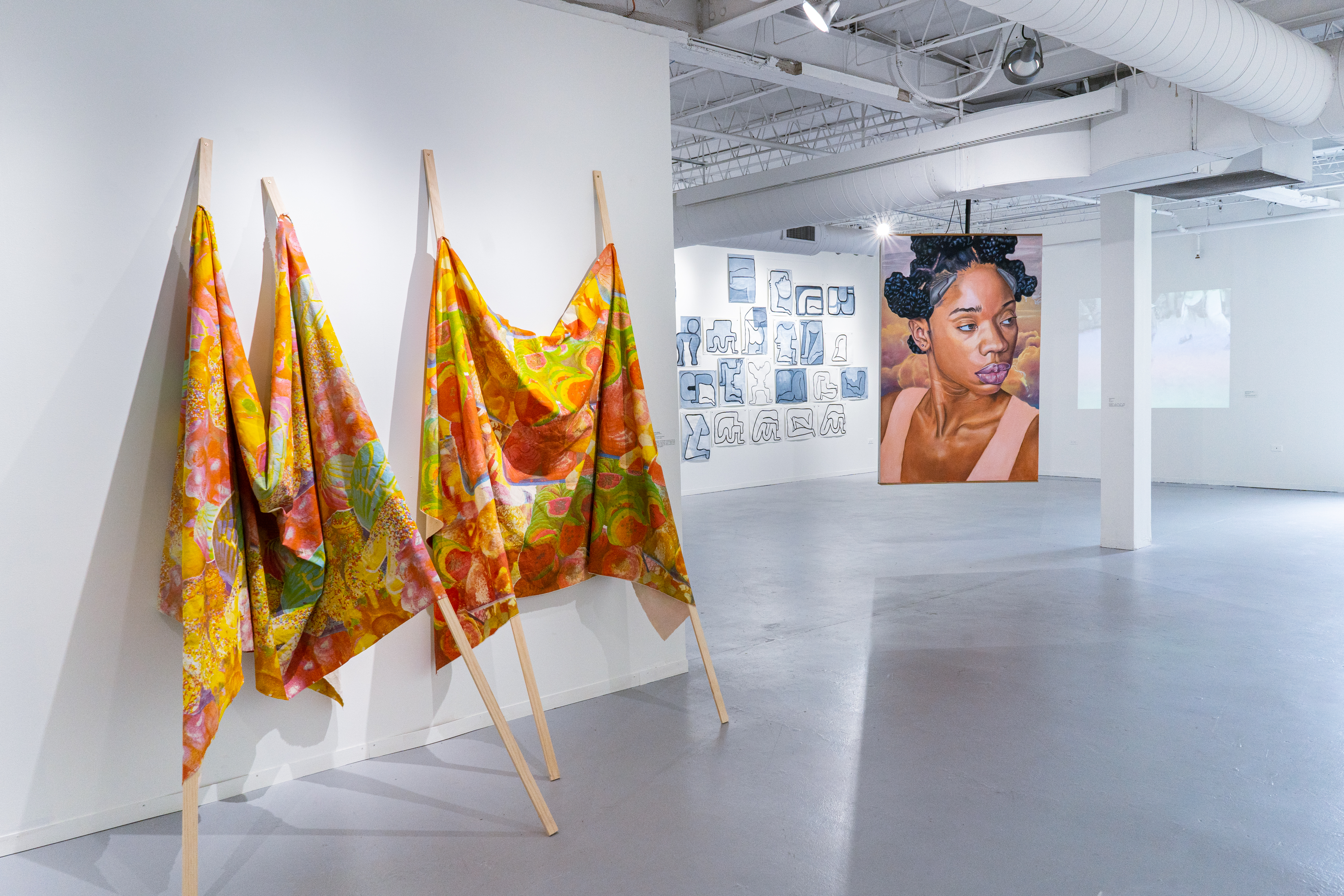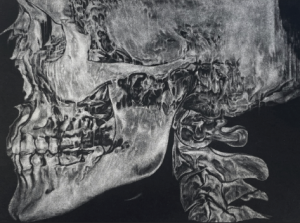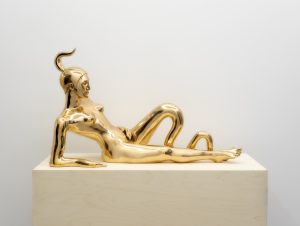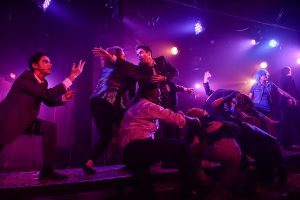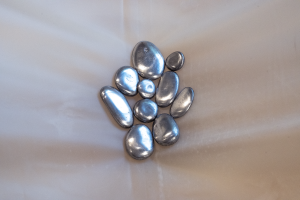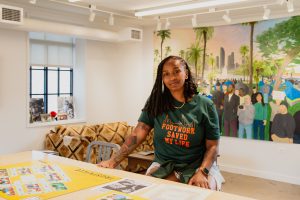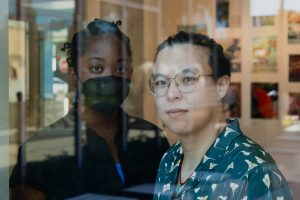At the Hyde Park Art Center’s “The Tokyo Show,” curator Asha Iman Veal forms a transnational dialogue on identity and diaspora; a conversation that crescendos to a fluid, thoughtful, and critical political affirmation: Black is Beautiful. As Veal states, “Chicago has taught me that there is still so much in this country that sees only black and white. That it is a political action every step of every day to be Black.” “The Tokyo Show” critiques the limitations of histories imposed through white supremacy, — histories of otherness, captivity, and subjugation —, through challenging and expanding the intertwined spheres of identity and the political. Veal’s writings consider what it means for people of color — Black, Latinx, and Asian communities — to craft allyship claiming reconstitution of “the center,” an evolution of discourse, and the transformative power of embracing Blackness on one’s own terms: the freedom for any young person of color to be solely themselves.

This is the inaugural installation of “Tokyo Show.” Artists include Carris Adams, Brandon Breaux, Amy Sanchez-Arteaga, Misael Daiz of Cog-nate Collective, Alex Bradley Cohen, Sarita Garcia, Jose Resendiz, and Diana Quinones Rivera. Also included is a black and white documentary piece, “The First World Festival of Negro Arts,” centering on the titular festival that took place in Dakar, Senegal in 1966, by the late filmmaker William Greaves. Artists Desiree Coral, Ishita Dharap, Clemens Melzer, Lavie Raven, and the curator Bisi Silva also contributed audio recordings. In addition, there are library collections attached to the project with additional multi-site artist ephemeral collections currently taking shape in cities such as Berlin and Lagos. Veal and I recently spoke, tracing the heart of “Tokyo Show,” and Veal’s curatorial mission to take on “the artistic and political task of seeking ways to constantly expand one’s space both literally and figuratively as a necessary challenge.” The following interview was lightly edited for brevity and clarity.

Annette LePique: What form are the current artist ephemera collections taking? What differences and similarities have you found in updates from the library collections in Lagos and Berlin?
Asha Iman Veal: Originally, “The Tokyo Show” was scheduled as a project for Fall 2017, as a multi-site exhibition activating a variety of settings in Tokyo, Japan, such as independent bookshops, apartment galleries, private and nonprofit arts spaces, and arts centers. Part of the goal was for artists and artworks to be active and accessible as both exhibition and resource at different locations around the city. Planning this on an independent budget, I’d been thinking of ways to travel with and ship artists’ works in a way that wouldn’t be expensive. So obviously projections and video came to mind, as well as photography that could be printed on-site. In another model of how to make artwork affordably portable, and unique pieces that could really personalize an individual’s voice and story, I spent a lot of time at the Joan Flasch Artists’ Book Collection + Archives at SAIC looking at examples from the object-based publication “The Thing Quarterly,” that ships out from San Francisco. In thinking about minimalist yet impactful exhibition formats, I spent a lot of time looking specifically at examples from exhibitions of design and designed objects, and found inspiration from recent years of the Istanbul Design Biennial.
So this idea for the ephemera/resource collection originally came from thinking about feasibility: What could artists easily say yes to? How to plan an exhibition long-distance, making the installation less complicated? How to transport works more easily and inexpensively?
In launching “The Tokyo Show” here where I live in Chicago, the opportunity to show larger work became real. But I’d still spent so much time thinking about logistics and possibilities before this opportunity, that I wanted to make it happen that way too. That’s when it became clear that the resource/ephemera aspect didn’t have to be as a single exhibition, but an ongoing circulation and disbursement that connects directly to collections abroad and is able to offer work and perspectives from Black and Brown artists that wouldn’t necessarily be accessible otherwise, and opens a direct and unmediated relationship and conversation to artists and communities. There’s a self-definition and a direct representation that occurs in this way, that’s so different than commercial and new media and stories or politics. It’s an opening for wider conversations and exchange, in ways that I feel can be so important for the artists and also for the people looking through these collections. This is much the same way that I’ve encountered so many materials at places like Joan Flash, archives, collections, museums, and all sorts of spaces of cultural accessibility and preservation. For me, this is how you move and how you meet people sometimes long before the moments and evolutions in your life when you’re actually able to do it …
Also, I have this thing about figurative and actual space, that it’s an act of defiant self-care and magical revolution to disrupt and prove the flimsiness of so many spatial imaginaries that seek to limit human beings as individuals, as people of color, as women — or as anyone who doesn’t want to buy into structures that seek to limit their movement and others’.

So in starting an ongoing collection by artists of color that will travel distances and move, to be held and cared for in places unexpected and away from home, this to me is a simple action of subversion, magic, love, and humanity. Quite literally, the works of different artists will land and be housed in different places, in ways that they can interact and hopefully be in reciprocal dialogue with the local population and community.
AL: How do you feel advocacy and social justice play roles in your own practices as a curator, educator, and arts administrator? Perhaps you could speak on some of your upcoming classes at the School of the Art Institute of Chicago and the intersections you see between pedagogy and activism?
AIV: In the classroom, it’s my goal for students to understand that they are individuals — not archetypes. We work together over the course of a semester to create our group and environment in a way that builds confidence, and super importantly, achieves and models equity. To prove that it can be done and to spend time in what this feels like. So that later in life when other types of situations and environments may push them to view themselves differently or to encourage the acceptance of disequitable circumstances, they can remember the possibility and success of something that felt different. And they can choose to push back, for an equitable space to happen again.
AL: How do you navigate situations as a curator, arts organizer, administrator, and writer when work or artistic partnerships cross the line from appreciation of Black culture and collective solidarity to fetishization or commodification?
AIV: Without naiveté, this is the discussion I am least interested in having, at least very specifically when it comes to the young women who have been open and kind when I have visited one of their fashion shops. What is quite interesting to me, is to see women choosing to be closer to brown in a world where “fair” skin, particularly for women, is often considered as a marker of beauty, desirability, or status.
This is something that I spoke about with other women, who were not part of the local Hip Hop scenes during my last trip to Tokyo in October 2016. They were self-organized arts leaders, one for a nonprofit art space, and one for an independent bookstore and gallery. In separate conversations, we spoke about women and the many different ideals of beauty that are based on historical and commercial colonialism, and what it could mean to take an opposite stance. Creating spaces to disrupt that, through language and statements like ‘black is beautiful.’
AL: What inspired you to craft the public programming elements of the exhibition, specifically what drew you to partner with Asian Improv aRts Midwest and Kioto Aoki’s “Shikou Kairo: Patterns of Thought” (at the Hairpin Arts Center)? What sorts of communal partnerships do you envision going forward with “The Tokyo Show’s” library collections?
AIV: Kioto Aoki and Kiyomi Negi-Tran, of Asian Improv aRts Midwest, are genius powerhouses as artists and arts organizers. Kioto and I knew each other from around town a bit. We met at an exhibition of her work at Chicago Artists Coalition in 2017. The following summer she spoke with students from the SAIC Flexible Arts Worlds class during a field trip to 6018 North, then donated prints to an archive and book project the class had been working on. This year, with the intersecting timelines of our exhibitions “Shikou Kairo: Patterns of Thought” and “The Tokyo Show,” it seemed like a perfect moment to collaborate intentionally. One of the artists from “The Tokyo Show,” Diana Quiñones Rivera, screened a film in the exhibition space at Hairpin and we did a public talk. Two of the visiting artists from Kioto and Kiyomi’s Obihiro exchange, Daisaku Ueno and Hiroshi Mehata, came to Hyde Park Art Center to give artist talks on their own work and for a private tour of “The Tokyo Show.” During the tour, the Obihiro artists immediately recognized symbolism in artist Brandon Breaux’s large-scale oil paintings “Pilot 11” and “Bernie – Love (2017),” two reimaginations of anime with women of color as the protagonists, referencing the original Japanese series “Akira” and “Neon Genesis Evangelion.”

These two shared events were great moments of exchange.
It will be cool to plan a few more events in the exhibition, for the summer. “The Tokyo Show” is up through September 29, and EXPO week, so there’s still a lot of room. Our opening reception coincided with the 80th birthday anniversary of Hyde Park Art Center, so that in itself was an amazing day.
AL: Could you speak a bit on your archival work with ephemera and images from various stage productions of Lorraine Hansberry’s “A Raisin in the Sun?”
AIV: These images from various stage productions of “A Raisin in the Sun” first came to my attention back during graduate study as well, in wanting to learn more about the concept of ‘intercultural performance.’ I came across the “Raisin” images in a special issue of “Theater Journal” devoted to the topic, and an essay by Katarzyna Jakubiak that explores the history of these performances that took place in Poland and Eastern Europe in the 1960s. Astrid Haas is another scholar who’s written on this, from a European perspective in studying U.S. cultures. Seeing these stage plays done abroad in political context and in blackface, caused me to consider this as part of a global history of how this very American, very African American, very Chicago play has been translated in more than thirty languages and produced globally since it’s Broadway debut in New York in 1959. “Raisin” was the first such work by a black American and female playwright to receive that type of platform and consistent interest, although it feels to me like the immensity of this story and play aren’t widely celebrated here in the U.S. as such a significant and one of our most important stories within the American canon of literature and stage. As recently as in 2016, theater companies in Sweden continued to perform “Raisin,” not in blackface and starring Afro Swedish actors. The goal here was more specific, not to imagine or explore race, but to consider that country’s own, current context, experiences, and positions of multiculturalism. It’s amazing to dig into how “Raisin” has been so important and resonated with audiences nearly literally everywhere for sixty years. This is something that fascinates me, and also that shouldn’t be understated. Hence the curatorial research and eventual exhibition, blending archival images and responses by contemporary artists.
AL: What is your process for finding generative meaning in the difference of diaspora (Black American experiences being different than African experiences) and how that simultaneously complicates and strengthens ideas of Blackness?
AIV: The global curator Bisi Silva passed away earlier this year, and she was one of the most generous and deeply intelligent humans our time has known. Bisi was based in Nigeria, and accepted a collaborative invitation from SAIC, Hyde Park Art Center, and Northwestern to visit Chicago for a short-term residency back in April 2017. There’s an audio piece in “The Tokyo Show” that includes five minutes of Bisi speaking about her practice as an arts organizer continentally and across so many farther geographic borders. The black and white William Greaves film that’s in the exhibition, “The First World Festival of Negro Arts” (1966), shares documentation from the major cultural statement and convocation that sought to unite the diaspora that year in Senegal. In the exhibition overall, Carris Adam’s silhouette drawings of the four Moor pillars of the Doge Pesaro monument in Venice 1669 (Untitled 2019), are in conversation across the room from “R.E.S.I.S.T.” by artist Jose Resendiz (2019), and his 96 barcode panels of laser-cut wood displaying the names of human beings living in U.S. detention camps, representative of serial numbers assigned to imprisoned immigrants. This is near another audio piece, recorded in Ecuador by artist Désirée Coral, on the topic of mobility, language, and the ignorance of stereotype.

There’s a room full of conversations, complications, and strengths in this show, beyond archetypes and poles, quite intentionally. Tokyo, black, and brown, wouldn’t necessarily be thought to come together, but in this space they do.
Featured image: A mid-distance photograph of a gallery. Leaning up against a wall are four pieces of wood. Draped between them are colorful fabric. In the distance, Brandon Breaux’s 2017 painting Pilot 11, featuring a figure with black hair and a blush shirt, is visible. Image Courtesy of Curator and HPAC.


Annette LePique is an arts writer, educator, and archivist. Her research interests include cinema, race, illness, and the body. She has written for Cleo Film Journal, Another Gaze Feminist Film Journal, and Dilettante Army. Annette was a 2017-2018 Research Fellow at the Chicago Psychoanalytic Institute and is completing her graduate studies at the University of Chicago. She is an active performance artist with a background in dance and music.
